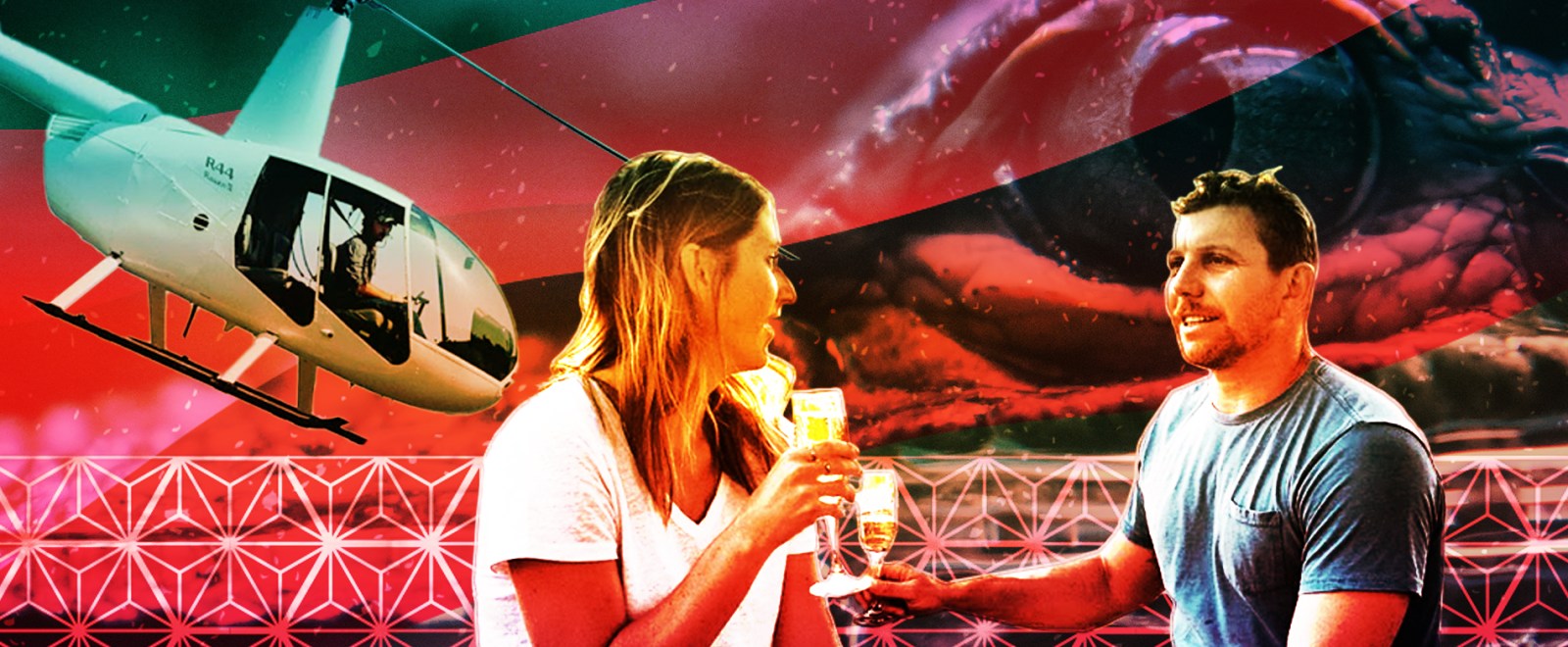
“Oi. Oi,” calls Jock in the throaty register I’ve come to recognize as his “crocodile voice.”
He splashes the water next to the dock with the top of his baseball cap, keeping his eyes trained on the edge of the lagoon 50 or 60 yards away. “Oi. Oi.”
A faint shape materializes on the surface of the greenish water, shimmering in the reflected afternoon sunlight. It’s there just long enough to recognize — long snout, twin hillocks for the eyes, the faint, irregular outline of a long tail — before it disappears again, completely invisible.
“Oi. Oi.”
Jock, his eyes still locked somewhere in the middle distance, steps back from the edge of the dock. I’m looking the same direction, a few steps back from a sign reading: DANGER CROCODILES. Please remain at least one metre away from the water’s edge at all times unless accompanied by a staff member.
I don’t need to be told twice. When the crocodile guide steps back from the edge of the dock, it probably means something. A few seconds later, there’s a loud clang as the crocodile’s… head? snout? slams into the dock with enough force to push one of the tire bumpers sideways, generating a big splash. You know that scene in a horror movie where the still unseen antagonist suddenly slams into the boat/car/house/door? It’s standard imagery and for good reason: it’s the moment when an abstract threat takes physical form. “Maybe I’m just overthinking this. Maybe it’s all in my head” you silently wonder to yourself, and then CLANG! The internal monologue vanishes and you smash cut back into the present.
The croc is finally fully visible as it glides slowly around a corner of a slip. It’s probably most terrifying in this form, visible just underneath a foot or two of water — the better to magnify its massive size. The saltwater crocodile is the largest reptile on Earth, the males up to 20 feet when fully grown. This one, Jock tells us, is named Otis. He’s not tame or captive, just familiar in these parts — a local. After maneuvering around the corner of the dock, Otis swims slowly towards its backside. There are steps down into the water back there, leading to a fenced in area underneath the water. Jock tells us we can “swim with the crocodiles” in it — sort of like a lower-tech, chainlink version of a shark cage. I’m already closer to a live crocodile than I ever planned on being in my life, and being underwater with one is the stuff of nightmares. Thanks but no thanks, Jocko!
Baki, a TV personality and GoPro ambassador from Malaysia who’s on the tour with us, volunteers to go into the cage. I guess that’s how you become a GoPro ambassador. As Baki descends the steps I’m full of nervous energy, compelled to fill the silence even though I have nothing worthwhile to contribute. “Is the water cold?” I hear myself asking, idiotically.
Otis the croc slowly opens his mouth as he approaches the dock. And then… he just kind of floats there motionless for a while. It’s almost as if his operating software has frozen and he needs a reboot. Perhaps this is strategic. The better to lull you into a false sense of security. The instinct to run away competes with the instinct to bop him on the snout just to make sure he’s still alive. I have a distant memory of throwing pennies at the alligators at the Exploratorium as a child. The croc’s inscrutability amplifies the fear. Crocodiles aren’t just deadly killing machines — sharks, big cats, hippos, wolves, etc. all possess that ability — it’s also that they don’t seem to have thoughts in the same way, lacking legible emotions, or consciousness as our mammalian brains understand them.
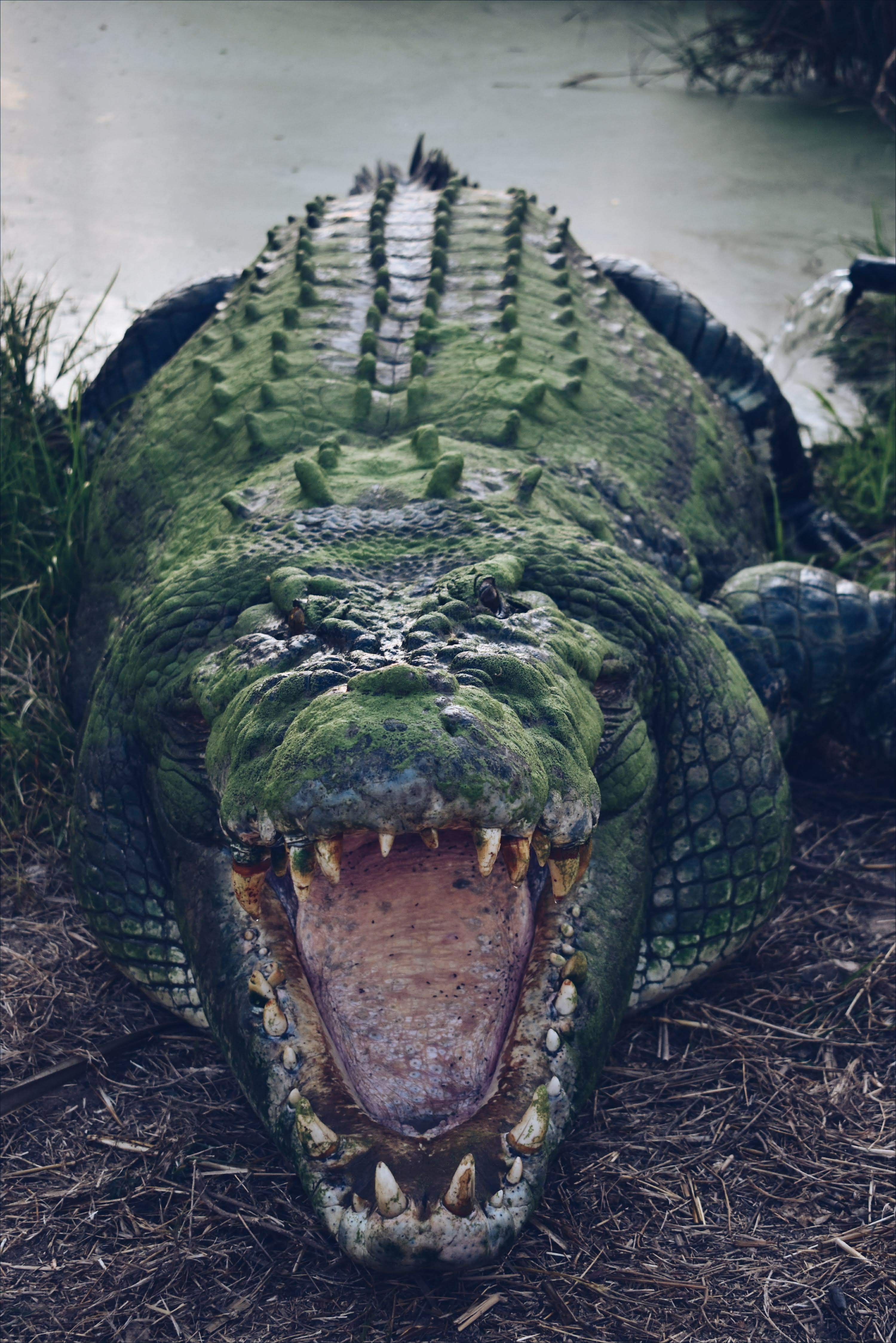
Remember when Werner Herzog looked into the eyes of a grizzly and saw only “Za cold indeefference of nature”? Crocs are the embodiment of that, old testament nature. They seem as likely to sit there, still as a rock, as to strike at you with lightning speed. It’s the unknowability as much as the teeth.
Otis sits there with his mouth open for one, two, five minutes. Jock leaves him be, Baki steps out of the chain tank, and our group piles onto the Top End Safari Camp fan boat.
Jock, who’s about 25, drift races the flat bottom boat around the wetlands of Australia’s Northern Territory, fishtailing around stands of reeds and bouncing over logs where puddles and trickles meet rivers and massive crocs lounge on the banks (and presumably lie hidden under the surface). We’ve arrived during the dry season, but there are high water marks halfway up the scrubby trees lining the tributaries showing where the wet season levels would be — 10 feet over our heads. In a few months, the whole place would be a giant lake.
Jock stops the boat in a narrow waterway where a medium-sized croc lies half-submerged next to the bank. The boat, which is essentially an open platform with a waist-high chain railing around it, is nearly touching the croc, which is at least 10 feet long. Jock gestures to its head while describing features of its anatomy, standing right next to it. He’s almost touching it. And then he does touch it, right on the head.
This is the guy I had let fly me around in a helicopter less than an hour earlier. It was my second helicopter flight ever. I’d gone up with a tour company in Kauai about six months earlier, and when I did, there were hours of tourism board warnings — telling us to take Dramamine, putting us on a scale, arranging us by weight — plus a full safety briefing. In Australia, we got into a small, five-seat helicopter with no doors and the safety briefing consisted of the 25-year-old pilot explaining, “Yeah, mate, weah gonna go up in the choppah” in his nasally North Queensland strine. (All of this was before Kobe Bryant.)
Now I was watching the same guy touch a live crocodile’s eyes and nostrils to demonstrate “the only soft pahts of his skull.” When you imagine who you want flying you around in a helicopter or piloting a fan boat through a crocodile-infested swamp, you hope it’s someone for whom “safety” is his middle name. I’m not sure this type of person exists in Australia, where most of the men are named Jock.
The rest of the skull is made of bone, apparently. Jock, it seems, knows this particular crocodile as well, which is missing part of its lower jaw from a fight. Jock shows us this by physically lifting up the crocodile’s snout until it moves its head out of the way, damn near grabbing it by the teeth. After this demonstration, Jock climbs back into the driver’s seat of the fan boat, sliding us around the narrow waterways like a giant watery quad bike. Hey sure, no worries, mate.
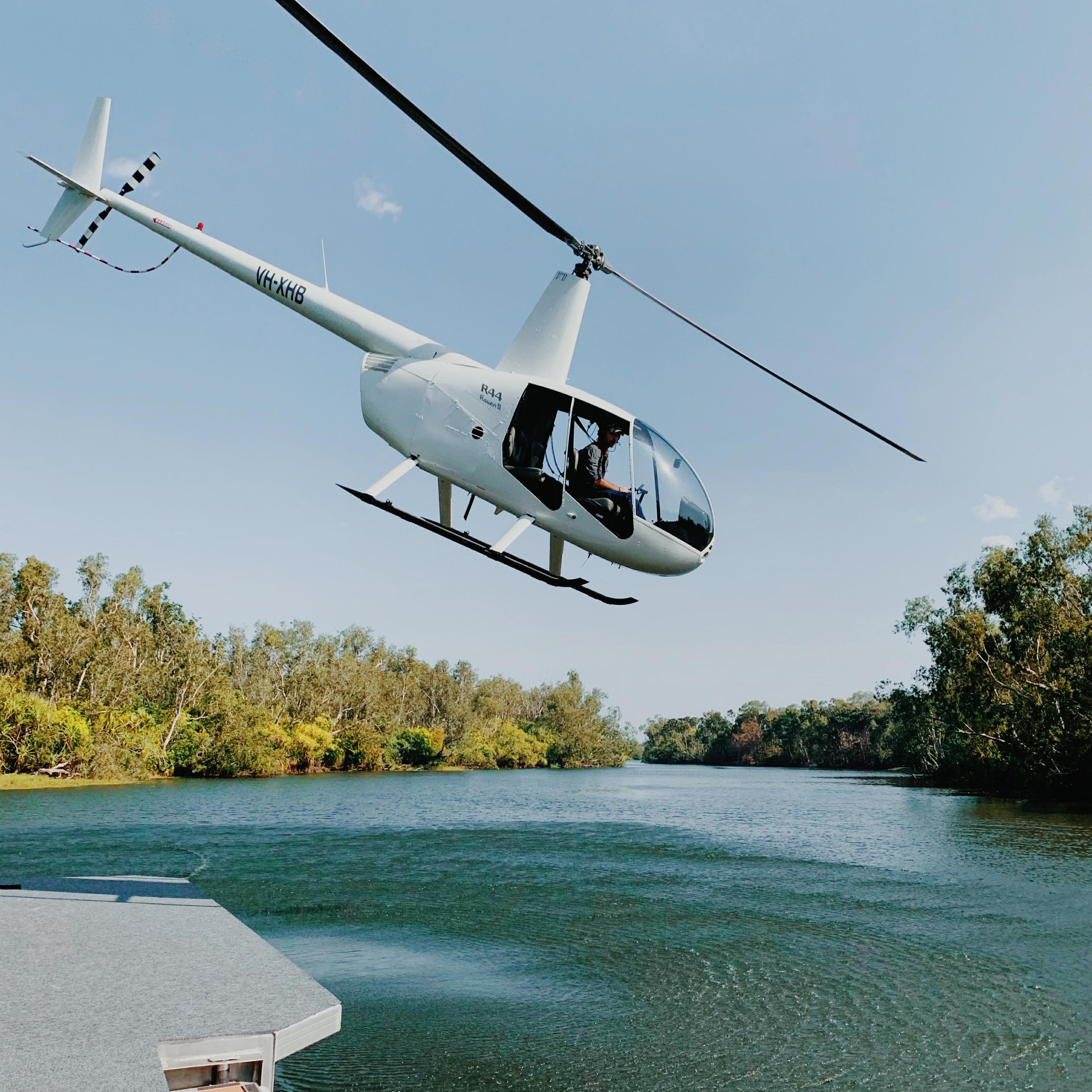
Next, Jock pilots us to the middle of a wider waterway for an encounter with a bigger, friskier croc. We glide to a stop and he starts doing his crocodile call again, lightly slapping the water with the top of his camouflage baseball cap. “Oi… Oi…”
Once again, the croc seems to materialize 20 or 30 feet away, then disappear, only to reappear again about 10 feet away. Is there a way to compare crocodiles to Romulan warships without sounding like a huge nerd? Anyway, that’s what they’re like, materializing and dematerializing as if by cloaking device, all physical exertion basically invisible.
Jock tells me to hand him my camera. I unlock my iPhone for him and he starts filming, leaning over the railing on the flat-bottom fan boat. The croc swims toward him. Jock isn’t holding food, or luring the croc like a matador with a red cloth. No, the croc is coming for him. He is the bait. As it gets close, the croc lunges out of the water to about waist height with jaws open wide, snapping at the phone in a perfect Instagram moment before disappearing back into the water. Holy shit.
After I’d posted the video, a friend of mine sent me a link to a story about his childhood neighbor, a doctor on a medical mission to Africa who’d been plucked off his canoe during safari trip in Botswana. A Nile crocodile (much deadlier than Australian saltwater crocs in terms of body count) had leapt from the water, snatched the man from the canoe, and pulled him under to eat him. His wife of 18 months, riding in the canoe behind, witnessed the entire thing.
I hadn’t known that story at the time, of course, but even so, I wasn’t nearly as afraid as I would’ve imagined myself being. Jock, along with his boss at Top End Safari Tours, Matt Wright, whose wife was having a baby when we visited, collects crocodile eggs as part of a wide-ranging conservation effort (as profiled in Nat Geo’s Monster Croc Wrangler). The tours are only one aspect of the business.
As theoretically terrifying as being around a giant crocodile should be, I found myself unable to generate much panic around someone so thoroughly sanguine. Jock had a preternatural chill about him that was so all-encompassing as to be oddly contagious. All Australians seem to possess this to some degree, even the other 99.99% of them who want absolutely nothing to do with crocodiles. A people that treat virtually any life event with a good-natured shrug was a big part of why I found the place so captivating. It’s a hard place to worry.
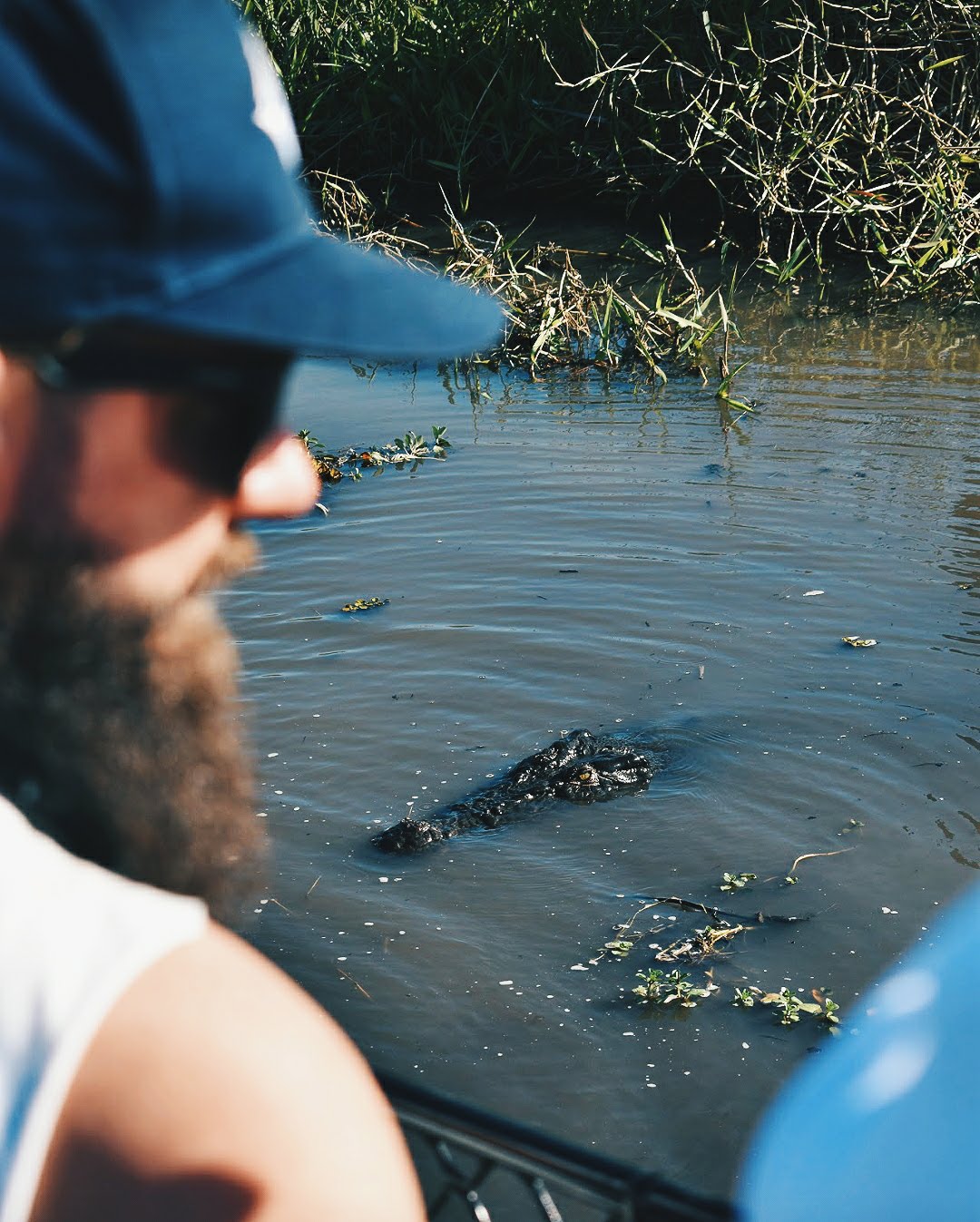
This was my first trip to Australia in almost 17 years. I’d first come in the early aughts for a semester abroad, my first real trip outside the country, excluding day trips to Mexico. The 14 hours from San Francisco to Sydney was one of my first plane rides, crossing the international dateline and losing an entire day along the way. Imagine that, an entire day, just poof, wiped from the calendar.
I know everyone falls in love with the place where they studied abroad to some extent, returning with an insufferably faux-worldly air and adopted new vernacular — “oh cheerio, chaps, is this the way to the metro?” But, and go with me here… for me it went further than that. Partly because I had arrived as a virginal, not-quite-formed human and left as something much closer to the adult I would one day become, sure, but partly because of the place itself.
For as much as Australia is the most preposterous country on Earth, there was a palpable sense of community like I’d never experienced. Not like a hand-holding, stranger-hugging kind of community, more a good-naturedly needling, piss-taking kind of community, where Americans were casually referred to as “seppos” (as in septic tank, as in generally full of shit). It reminded me of my own family, where love is often expressed in the form of a roast. Australia is a country of eye-rollers, of rib elbowers, of ball busters. They don’t let you get away with the casual peacocking that’s so common in the US. Perhaps as a result, you do meet fewer insufferable people there. It’s hard to go to a bar in Australia and not leave with at least one new acquaintance.
I hadn’t even considered the possibility of travel abroad until I met an Australian exchange student playing rugby. He was a lunatic, who would hector people into drinking, sing unimaginably vulgar songs and regularly pass out stark naked on disgusting beer-encrusted floors. He once got us thrown out of a cab ride for repeatedly and affectionately (?) calling the driver “cabbage.” “Oi, cabbage!” he’d yell. To which the cab driver, for whatever reason, took great offense. This feral Australian regaled us with tales of a magical place where one could do this all the time. A place called the University of Queensland.
On my first afternoon at St. John’s, the small Anglican sub-college at UQ (a glorified dorm, essentially) I walked into the dining hall. I’d arrived at the tail end of a semester break so there were only a handful of people there, and I did what I would’ve normally done in a dining hall back home — found an empty table. This, I was soon informed, was not how things were done.
There, you took whatever the next open seat was and filled up each table one by one. In this way, it wasn’t long before all 200-odd students pretty much knew each other by name (or nickname, as often as not). They had other weird traditions too. If you said the word “tea” or “coffee” in any context, you had to bring tea or coffee for the whole table. It was strange and Harry Potter-ish (for “formal dinners” on weeknights, you had to wear a black robe like a judge), and the food was usually terrible, but despite the bewilderingly foreign trappings, I soon found a college experience much closer to the one I’d always had in my head. Not beaches and bikinis maybe (those Girls Gone Wild commercials corrupted expectations for an entire generation), but a more communal experience where everyone sort of knows each other and people acquire familiar nicknames through constant ball-busting and drunken hijinks. It was a place that, at that time in my life, felt right in some deep way.
Upon visiting Australia in the early nineties for his book The Happy Isles Of Oceania, Paul Theroux, one of our greatest and most crotchety travel writers, put it slightly less charitably:
Australians (it seemed to me) were people who appeared to be at ease when in fact they were simply controlling their emotions, and being on good behavior, because the slightest relaxation of this stiffened vigilance would have them howling. They were like people who had only recently been domesticated, like youths in their late teens sitting among adults, rather upright and formal and wooden, because as soon as they loosen their grip or have one beer too many they slip into leering familiarity and all hell breaks loose. What you took to be good manners was simply the forced, self-conscious behavior of someone holding on. Much of the time Australians had the exaggerated and unconvincing manners of drunks pretending to be sober.
Suffice it to say, the place got into me. I felt genuine grief when I had to leave.
I spent much of my unhappy, professionally demoralizing twenties (the mid-aughts were awful, especially if you weren’t a mortgage broker) scheming of ways to go back as I bumbled through a series of crappy jobs — porn editor, barista, copywriter for an SEO company, copywriter for a college loan company, waiter at a hotel, copywriter for a porny social media network… Most of these I got fired from. I thought I’d maybe go to graduate school there. Instead, I got into a more “prestigious” program in New York, where I’d applied basically on a whim.
So I moved to New York. I got another degree. I got a job. I moved back to California. Australia receded to a lower rung in my personal origin story, a collection of fun stories. Was that all it was, a mirage?

17 years later, one of my good friends from high school invited me to his wedding outside Melbourne. He’d stayed in Fresno County where we’d grown up, working for a hotel chain. He had frequent conference calls with a coworker in Australia, and like the plot of some rom-com, they fell in love. After a few trips back and forth, a lot of Skyping, and eventually a proposal, he moved in with her father in a Melbourne suburb while they looked for place to live. The bride’s mother died of cancer just a few months before the wedding, which, again, seems like an almost too on-the-nose beat from a rom-com, a cheap way to add depth, if only it wasn’t true.
It was a wedding I couldn’t miss. I never imagined that a family of Australians would one day merge with a family from Reedley, California, one of the least cosmopolitan places on Earth. Or more to the point: I always assumed that if someone from our podunk town ever moved to Australia, it would be me.
I brought along my girlfriend, who, just to bring things full circle, is also from my hometown, and still lives nearby. We’d reconnected on a trip home. We both thought it’d be a fun little fling at the time and… yadda yadda yadda… it turned out to be much more. I’d done what I never imagined I’d do and come back home, while my friend had become an expat. Amazing what love can do, isn’t it? It was almost like we’d switched lives. Only instead of being upset about it, as some earlier version of me undoubtedly would’ve been, I was thrilled. That’s a part of growing up, probably, when you stop micromanaging the arc of your own story and let the universe have its say.
When I was planning for the trip, we’d been dating a few months. Serious, but with an ending still unwritten. By the time we were preparing to leave, I’d managed to put together a side safari to the Northern Territory complete with a helicopter ride. We’d been dating for almost a year. I knew she was “the one,” a concept I’d never before believed in. I realized that if I didn’t propose on this trip, anything else would be a letdown.
Our first stop in Australia was Melbourne, to visit Dan, an old friend from the dorms in Queensland who I’ve kept in touch with over the years and have now visited in six cities around the globe. Australians are obnoxiously worldly like that. Before Melbourne, I’d gone to stay with him in London and in Helsinki, where he’d met his Finnish wife, Pia. They’re one of my favorite couples, even if we only see each other every four or five years these days. My first memory of Pia was waking up in a hungover haze on their couch in Helsinki with Pia looming over me as I took my first confused blinks of daylight in Europe. “Do you like your eggs poached or fried?” she asked in her sing-songy accent (Finnish words sound like raccoon chatter, it’s hilarious).
Which is to say, they’re perfect hosts. When I first visited them in Finland, Pia spoke mostly flawless English, as most Scandinavians do, but peppered with the peculiar Australianisms she’d picked up from Dan, who grew up in North Queensland — which is sort of like the Alabama of Australia. She’d call a toilet a dunny, a quilt a doona, an ice chest an eski, and once described a friend being made fun of as “they were taking the piss right in his face.”
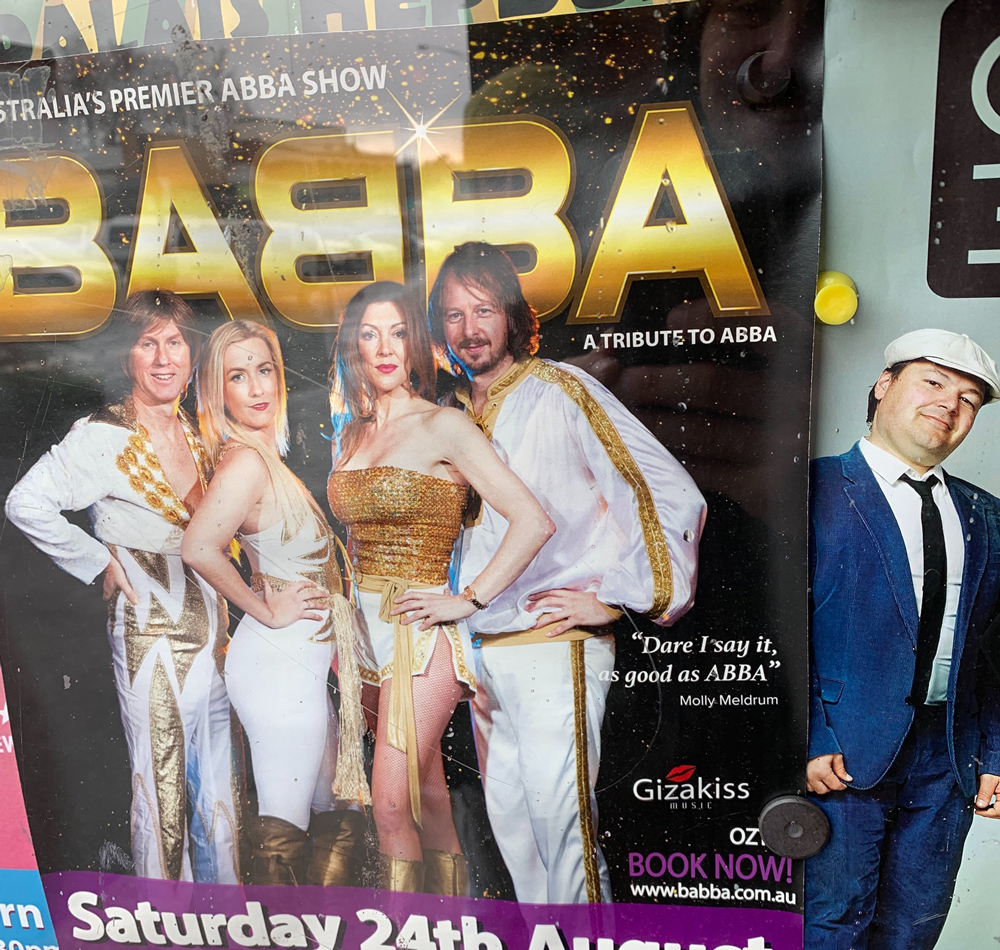
After years of living in Australia, the accent is even fainter and the Aussie-isms serve only to make her sound more like a local. They now live in a delightful suburb outside Melbourne, where most of the houses are made of tan bricks and the architecture looks a little like New Orleans meets the far east. Lots of the buildings have multi-level decks with decorative metalwork on the front, with the odd pagoda-like attachment thrown in. Dan and Pia had a spacious, open home set in a landscape of rolling hills and swaying eucalyptus where they live with their two precocious, rom-com-ready toddlers. Why do children with accents always seem smarter? (To be fair, these kids were bilingual so they actually probably were smarter).
I introduced them to my girlfriend. They let us sleep off our jetlag. We went for a jog at dusk and chased the grey kangaroos that forage in the morning and evening hours with our cameraphones like tourists. Australia exists now for me as this strange combination of the exotic and the familiar, inhabiting both memory and imagination, where I can still get excited about wild marsupials and knowingly point out quirks of the local palate, like the savory pastries (meat pies, sausage rolls) Aussies eat with ketchup (to-mah-to sauce, in local parlance). That Melbourne is so much like Northern California where I’d spent most of the past decade — a temperate cosmopolitan city on the bay surrounded by wine country — only deepened the sense of funhouse mirror deja vu.
Dan and Pia left the kids with their Mamma Mia-singing nanny (Australians fucking love ABBA, to an off-putting degree) and the wine flowed, even though it was a school night. Dan sagely advised that we have a few beers before we got into the wine. We reminisced about our rowdy college days and commiserated about becoming boring suburban parents (at this point I was essentially living with my girlfriend and her six-year-old). There was the time Dan took me to my first cricket match, Australia vs. England, at the Gabba in Brisbane, where we smuggled in a bladder of boxed wine (“goon” in the local tongue) and got threatened by some heavily tattooed fellow cricket goers, who thought Dan’s “the queen takes it up the bum” song crossed the line of acceptable fan behavior. Later we stopped at a McDonald’s (“Maccas”) where Dan broke a plastic broom over my head right as I tried to take my first bite, something I thought was a hilarious joke, then and now. Like many of his countrymen, Dan has a contagious and irrepressible mischievousness, another thing that charmed me about the place.
A few days later we left Dan and Pia’s for the wedding in Daylesford, a few hours away, driving an Aussie rental car on the left, trying not to hit curbs and cursing every time we hit the wipers instead of the blinker out of habit (which was often). The scenery alternated between rolling hills and dense eucalyptus forests. It began to rain and we passed pastureland where the sheep had turned reddish-brown from the mud. We’d rented a one-room cottage near the wedding with a botanical garden right out the back door. We arrived early in the evening and built a fire. When we woke up the next morning we discovered it had started snowing during the night. We opened the back gates into a garden blanketed in white, a winter wonderland in August.
It was a cold day for a wedding. The snow had turned into rain. We all packed into a cozy, wooden event space that felt like a secular chapel. Waiters walked around pouring wine and champagne, and, in true Australian fashion, never let my glass fall below the halfway mark. There were emotional speeches about the bride’s mother. The couple danced their first dance to Otis Redding.
We collected food and sightseeing recommendations from the wedding guests and, when we explained that we were headed up to Darwin for a safari soon, a few said, just as Dan had, that it would be a great place to experience “the real Australia.” Funny that even in one of the most urbanized countries in the world, where more than 80% of the population lives in big cities, the capital of Australia’s most rural territory, the one that’s most overtly an outlier, is still broadly considered the most “Australian.”
Australians have always been complicit in their own myth-making, going back to Crocodile Dundee. The film was co-written by its star, Paul Hogan, who had already starred in the Australian Tourism Board’s “Come and say G’day” campaign by that point, popularizing the phrase “put another shrimp on the barbie” to a generation of Americans (and another who experienced it second hand via Dumb and Dumber).
These days, you’ll occasionally hear an older Australian say “g’day” (“How ya goin’?” is far more common, and essentially ubiquitous) but they love to complain about being associated with “shrimp on the barbie.” It’s clearly inaccurate, they’ll point out. An Australian would never say “shrimp” to describe a crustacean large enough to be grilled, always “prawn.”
The other explanation for Australians positioning their rural places as most central to their identity is that they’re doing the same thing that Americans have: get nostalgic about the land they occupy as it existed before they conquered it. That’s the less fun version. Though somewhat understandable. Lots of places have skyscrapers and bridges. Not many have kangaroos and crocodiles.
We arrived in steamy Darwin fresh from snowy Daylesford. In the taxi line, I noticed a blonde woman who looked both extremely pregnant and, generously speaking, about 55 years old. Maybe she was actually only 40 but had lived some kind of rugged, crocodile dundee-esque lifestyle? When you’re traveling, every stranger’s face seems to tell a story.
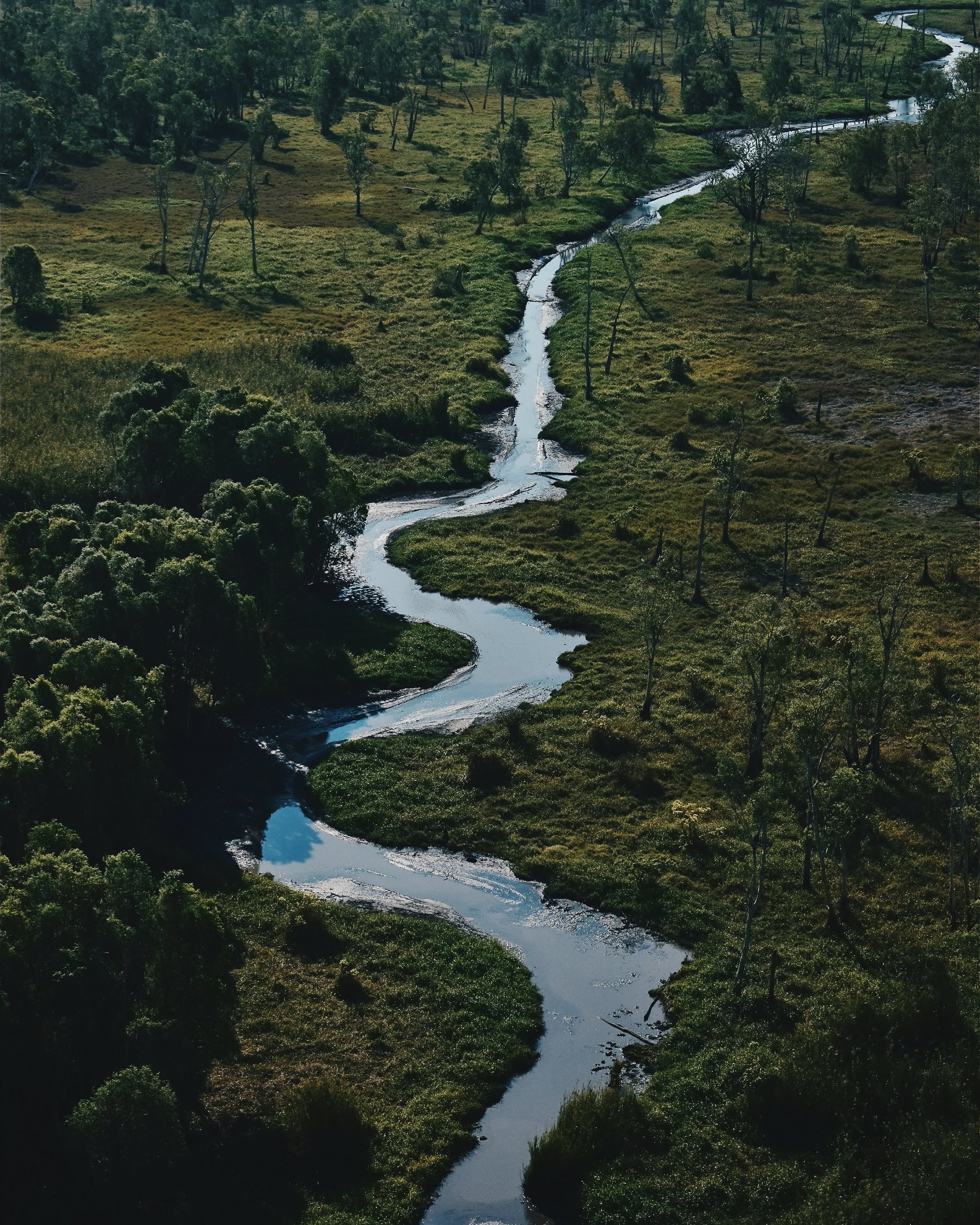
The next morning, the sun broke over the estuary across from the balcony of our hotel (which, in true Australian fashion, doubled as a casino). It was low tide and we walked out onto the beach towards the water until the sand turned to disgusting slimy muck. We went for a walk on the city side, strolling past banyans, with their dangling creepers, periwinkle-flowered jacaranda trees, and the occasional wild mango tree. I have an enduring sense memory of that northern Australian sun, and when it hit my skin, I was instantly transported back to Queensland. Back to walking home past lines of pale anglo school children in their old fashioned uniforms and elaborate skin cancer-mitigating hats — wide-brimmed straw boaters, or baseball caps with neck flaps. The sun in the Northern Territory feels closer somehow, more intense.
Jock eventually arrived at the hotel to pick us up in the tour minibus. We drove around Darwin picking up the other tour-goers, which eventually included Denise and Grahame, a retired couple from Queensland traveling around Australia on holiday, Rob, a single train conductor from eastern Victoria, and Baki, the aforementioned GoPro ambassador.
We got to talking, naturally, about crocodiles. Grahame and Denise pulled up a cell phone picture of a statue in Queensland, supposedly a life-sized replica of a giant crocodile shot by a woman in the 1950s — 8.6 meters long (just over 28 feet) according to later Googling, which does seem unnecessarily large. We oohed and ahhed and just at the perfect pause in the proceedings, Grahame drawled, “Apparently she used her husband as bait!”
Grahame, it would turn out, is an enthusiastic and capable purveyor of dad humor. In my experience, all Australian men are stocked with a copious but finite number of dad jokes in the womb, which they deploy frequently and skillfully over the course of their lifetimes until their supply of dad jokes is eventually all used up and they return to the red Earth, to become food for the grass on which the kangaroos and wallabies graze, beginning the cycle anew. On breezy days you can hear the wind whisper through the gum trees: “Oi, mate, workin’ hahd or hahdly workin?”
Grahame found out my girlfriend was a nurse and immediately exclaimed, “You’re a nurse? ‘ave a look at me toe!”
“Toe,” by the way, in Australian strine, like all O words, comes with an elongated, faint but distinct “oy” or “o’er” sound at the end. Toe becomes “tooooeey,” no becomes “noooooii” or “nooooo’er,” and so forth. Say it with me: “Ooo’er nooooiii! Dooooin’t goooy ta Utar!”
It’s the central feature of the dialect, along with the wildly inventive slang — something virtually every travel writer from Bill Bryson to Paul Theroux to Bruce Chatwin to William Finnegan has correctly identified as one of Australia’s most important cultural contributions (Theroux called Australian English “one of Australia’s glories and its greatest art form”).
Grahame put his sandaled foot up on the picnic table where we were having lunch, and sure enough, the third toe on his right foot was completely black and blue. He said he’d been watching “Hawoyi Foive Oooih” before bed and ended up doing “karate kicks in me dreams.” He’d walloped the side of his caravan and voila, purple toe. Denise had since wisely banned him from watching Hawaii Five-0 before bedtime.
The rural honky-tonk restaurant where we were eating, in Berry Springs, had some small crocodiles in a tank (you can order all manner of crocodile meat there to eat as well, which to me just tastes sort of like dry turkey). Jock showed us pictures of the albino crocodile that he’d found with Matt Wright, that Wright had let him keep as a pet. The word “pet” kept tripping me up, and I had to know: what does “pet” actually mean as it relates to what will eventually become a giant, potentially man-eating reptile? Does it… show affection? Recognize you as its owner?
“Nah, mate, he’ll grab ya,” answered Jock matter-of-factly. “Theah’s no love theah.”
I asked about some of the particulars of Wright’s conservation work, which involves collecting eggs, most of which would die in the wild, and raising them on farms, where they can then be sold for the skin and meat. It’s a valuable trade that proponents say marries conservation and commerce. A crocodile expert interviewed by the Australian Broadcasting Corporation called the Northern Territory “a world-leading model for helping poor communities via conservation.”
That work apparently involves sneaking around croc-infested swamps yoinking eggs from giant croc mothers. Not exactly my ideal profession, but that being said a lot of things sound preferable to the politics of digital media and online advertising. I asked Jock what they do if a croc comes after them. “Ya just stick the bloody crate in theyah mouths,” he told me, as if life is just a simple matter of following Looney Tunes rules. Duh, just stick the crate in the crocodile’s open mouth. If someone pulled a gun on me I would simply plug the barrel with my index finger and smirk.
We found out Grahame and Denise had been married for 40 years. “What’s your secret?” my girlfriend asked.
“Dad, I’m pregnant!” said Grahame.
Later that night at the campsite when it was getting dark, Grahame warned, “Don’t carry two lanterns — the roos ‘ll think yer a car and jump out in front of ya!”
Truly a master of his craft. When we sat around the campfire after dinner, we went around the circle drinking and telling jokes. “Why did the cane toad cross the road?” Grahame asked. “To see his flatmate!”
Bad dirty jokes are an area in which I felt like I had much to contribute, so I started in with the one about the couple at the nursing home. They were too old for sex so when they wanted to get intimate, they’d sit next to each other in their wheelchairs and the woman would hold the man’s penis. One day, she came back from a trip to the hair salon, only to find the man with a different woman holding his penis. “This is unbelievable!” she raged. “What does she have that I haven’t got?”
“…Parkinson’s,” said the man.
It went over pretty well, though less so with Grahame, who only chuckled politely. “Oy’ve got Pahkinson’s,” he said after a beat. A one upper ’til the end.
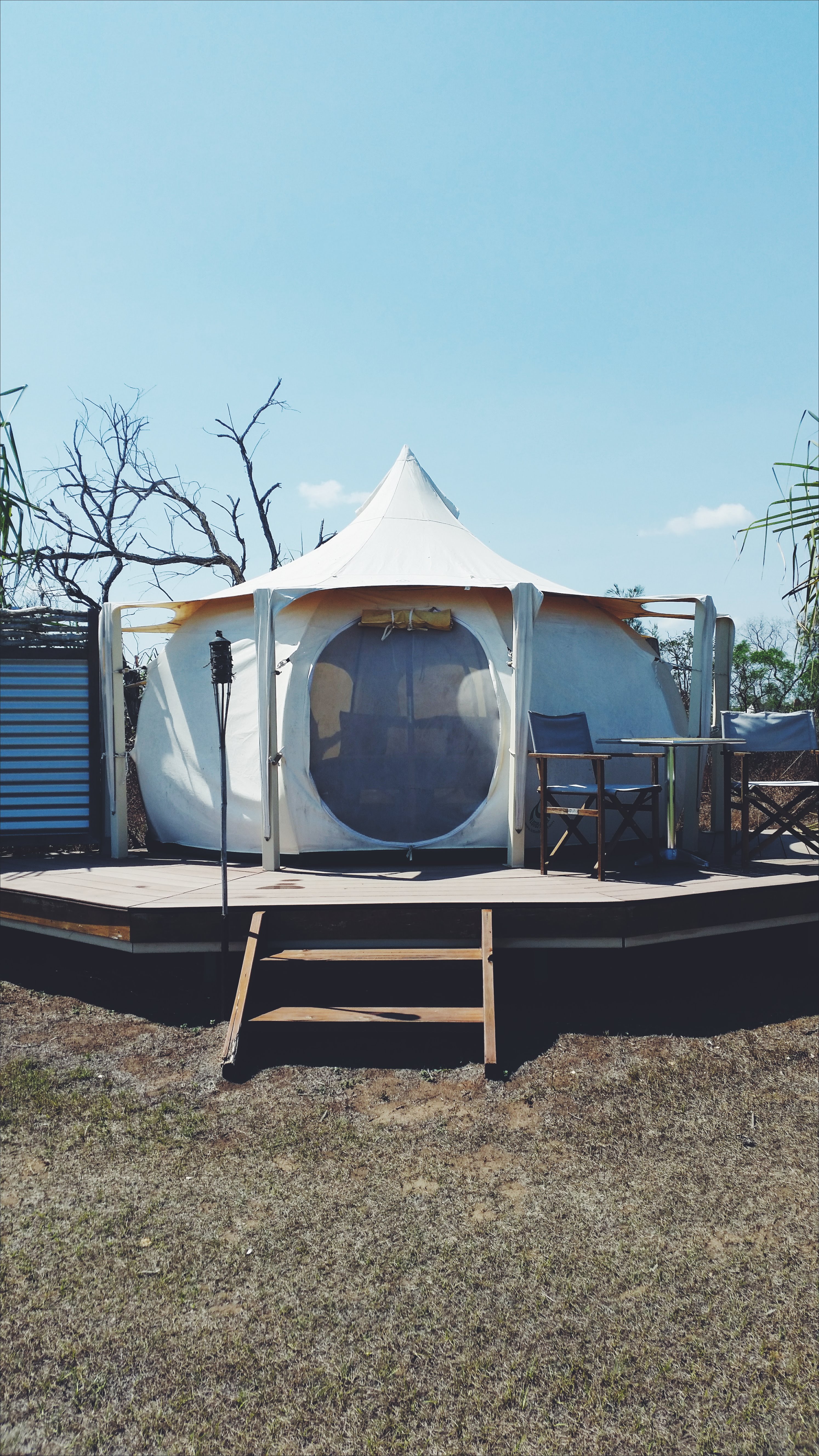
On the way to the campsite, we stopped at the Berry Springs Recreation area, which from the parking lot (carpark) looks like a glorified rest stop bathroom — the dry scrub indistinguishable from the miles and miles of same around it, extending to the horizon. But after a two-minute hike (past a sign that warned that the area is closed in the wet season because “increased water levels allow Saltwater Crocodiles to move into the area”), we found ourselves in paradise. Gentle springs feeding clear, warm bathing pools, with striped fish swimming languidly around your feet while bright green birds dive-bomb out of the trees to catch bugs above the water’s surface on their way back up to another perch. I never imagined I could feel so relaxed swimming in an area with a beware of crocodiles sign.
We piled back into the van for the trip out to the campsite, but not before a stop at the Sandpalms Roadhouse Tropical Motel, an extremely Australian establishment that combines bottleshop, tackle store, pub, restaurant, and campsite. It felt straight out of Crocodile Dundee. Every vehicle seemed to have a snorkel (which are sometimes an affectation in Australia, the same way mud flaps and big deer whackers on pick-up trucks that never leave the suburbs are in the US) and gnarled men in short shorts sat around outdoor tables drinking beer from stubbies and telling tales. There was a flatbed truck in the parking lot with a vanity plate reading “GNFISHN”. We were there stocking up on drinks for the evening. The beer selection was extensive and I had to consult the barwoman on which beers were regular beer and which were “mid-strength,” the Aussie near beer (or “session ale,” in craft brew-speak) designed for the all-day drinker. A tour guide for a different company sidled up to join the conversation. “They all drink mid-strength beahs heah. Oy tell ’em they could just drink full strength and go home at 11.”
I asked what the crowd at the Sandpalms is usually like. Locals? Farmers? Tourists? Fishermen? The tour guide shrugged and waved me away. “Ah, they’re piss tanks.”
Eventually, we headed back to our campsite. The Top End Safari Camp, more glamping than camping, consists of a cluster of white tents shaped like garlic bulbs set in a clearing amongst massive cathedral termite mounds, craggy sand formations two or three times the height of a person. We flopped around the tent taking silly pictures and then my girlfriend started to unpack. I realized it was probably go-time for proposal planning. I surreptitiously pocketed the ring, which I’d smuggled into the country inside a sock (forever grateful Qantas didn’t lose my luggage) and stuck it into the pocket of my swim shorts, hoping it didn’t make too obvious a bulge. I told her I was heading to the bathroom and went back to Jock and our other guide, Faye, to try to gameplan.
They had already been prepped a bit. I asked if there was a point in the helicopter tour when he could maybe just hover a bit. I pictured us floating gently in the air, framed over a beautiful Australian sunset like some antipodean Viagra ad (“antipodean” is a fun word you can use whenever writing about Australia), when I could make a short little speech over the headsets and I could give her the ring and everyone would clap and maybe some of them would tear up, touched personally by the obvious depth and purity of our love. I also imagined proposing in the helicopter would be cool and memorable and heartfelt without having to do the whole getting-down-on-one-knee thing, which always seemed so cheesy.
“Yeah, mate, oy reckon oy’ll put yous down neah the termoite mounds,” Jock proposed.
Or, yeah, I could do it near the termite mounds. It’s important to be flexible. Jock seemed adamant on this point and the man seemed to know his business.
***
They set it up so that our tour group of six would ride the helicopter in two separate groups, with our group consisting just of Jock, my girlfriend and I, and Faye, who brought along her own camera. As we lifted off, it immediately became obvious why my plan for a gently floating proposal would not have been possible. The helicopter was wide open on both sides, like the whirlybird version of a four-wheeler, and Jock piloted it accordingly, swooping around in big S-shaped arcs and drift sliding it through the air. It was like we were jet skiing in the sky. Which makes it sound scary, but again, if you ever want to learn to relax just surround yourself with a few Australians who steal crocodile eggs for a living.
The scenery was breathtaking. We flew around flat, grassy marshes and winding streams, with white cockatoos flapping around stands of skeletal gum trees, trying to get as many pictures and videos as we could, with vice-like grips on our cell phones to keep them from flying off into space and bonking some croc on the nose. Jock eventually set us down in a field of the aforementioned termite mounds, a stunning otherworldly landscape of golden grass studded with reddish, 20-foot tall natural obelisks beneath a vivid blue sky and burnt orange setting sun.
We hopped out of the helicopter and I started in with the mini-speech I’d been running through in my head. How I’d never believed in the concept of “the one” before I met her, and so forth. I won’t nauseate you with the details. “What is even happening right now!” she said, putting her hands to her face.
Realizing I couldn’t really avoid it, I got down on one knee. Again, it’s important to be flexible. No one cried, but if you want that reaction, probably don’t propose on a foreign continent after a helicopter ride between crocodile tours. Adrenaline tends to neutralize introspection. Otherwise, it was a pretty amazing day.
As we floated back into the dying orange daylight, I took in the scenery. I realized that even if I’d never live out my youthful dream of life as a romantic expat writer, this country that I love so much would always be part of our story. I hadn’t married into an Australian family, but I had found a way to rig it so that the place would always be as important to her as it is to me.
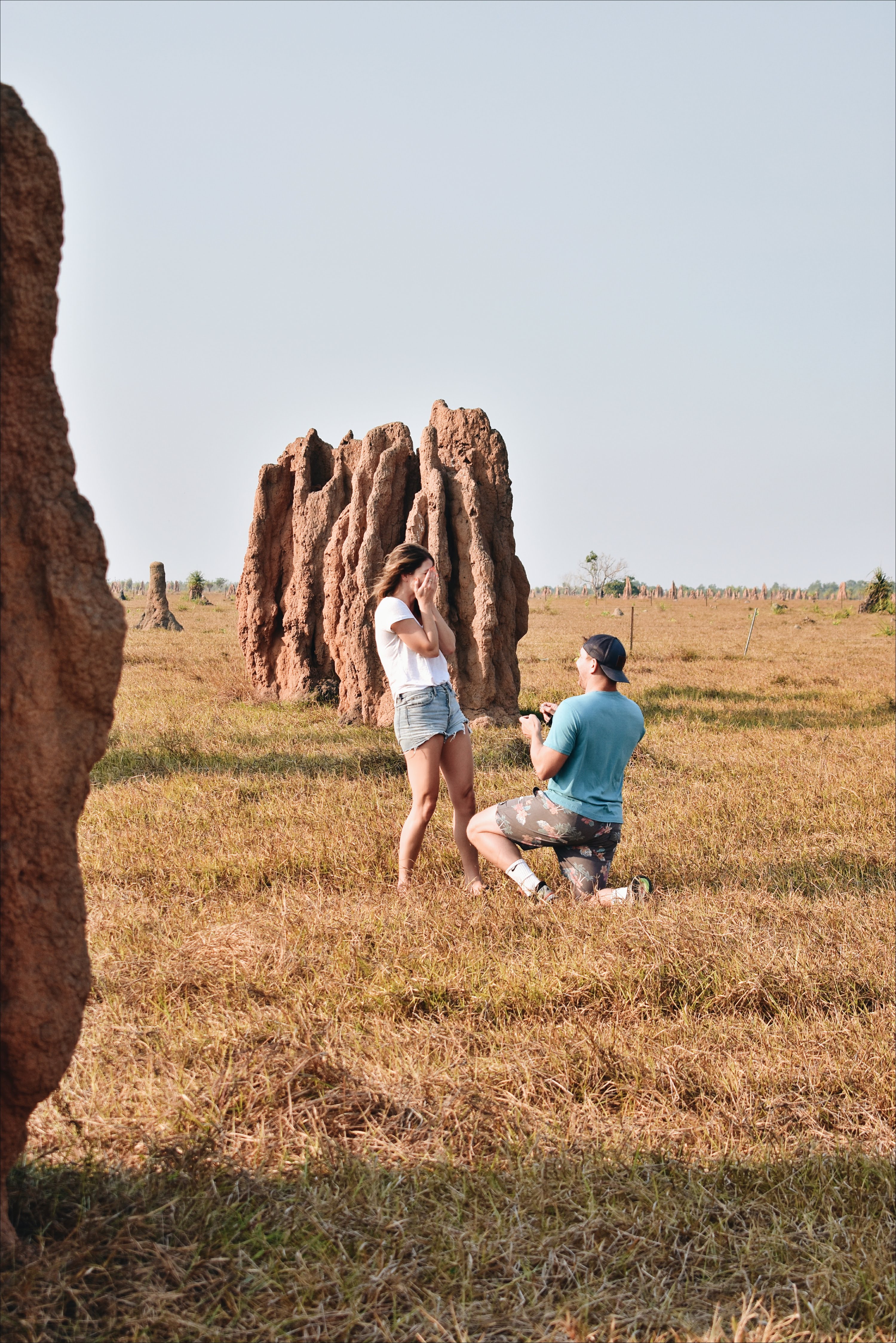
A portion of this trip was hosted by Top End Safari Camp. For the Uproxx Press Trip Policy see here.
